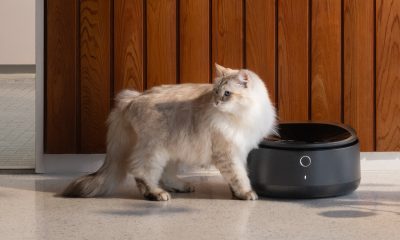Technology
How Samsung’s foldable phone will work

Flexible, foldable phones are about to become a reality.
Samsung finally unveiled its long-rumored foldable phone, which uses a new type of display technology the company has dubbed an “Infinity Flex Display.” Google also announced that Android will support these devices, saying it expects several more to be announced from other Android makers.
But these devices also mean we’ll have to relearn how to use our phones — again. Just as edge-to-edge bezel-less displays forced us to relearn basic navigation, phones that can fold up will also require a major behavioral shift.
With two different displays in play, we’l have to change everything from how we hold our phones to how we use apps and play games.
So how, exactly, will these devices work? While Samsung still hasn’t given us a proper look at its hardware (and probably won’t for some time), we got a pretty good idea of what to expect from the brief demo we saw onstage.
The 7.3-inch device folds lengthwise into a smaller device that’s closer to a traditional phone. When folded up, the front display is called the “cover display,” and it appears to function similarly to a normal phone. While folded out into tablet size, the front display goes to sleep, according to information provided during a subsequent developer session and reported by CNET’s Shara Tibken.
This will also require much more work on the part of developers, who will need to optimize their apps so they can transition between different-sized displays with different resolutions. And it’s difficult to overstate just how important this is if foldable phones are to become viable.
As we saw with Chinese startup Royole’s foldable FlexPai phone earlier this week, software will easily make or break the experience on these devices. Iin the case of Royole, the software experience is definitely closer to the “break” side of the spectrum at the moment.

Android will adapt to support foldable phones, according to Google.
Luckily for everyone involved, Google is already onboard. The company formally announced that it plans to build support for foldable phones directly into Android. The company’s head of Android UX, Glen Murphy, came onstage during the keynote to talk about how the two companies are working together.
For starters, Google will offer APIs that will let apps resize themselves when a device is folded or unfolded. The experience is supposed to be seamless, with an instant transition, what Google and Samsung are calling “app continuity.”
That way, users will ultimately be able to choose whether they want to use their apps on the smaller cover screen, or on the full-sized display. Flipboard, which also participated in the developer session, showed off how that might look.
In addition to “app continuity,” Samsung’s new extra-large display will enable even more multitasking uses. Android has supported running two apps at once since Android Nougat. But with the addition of foldable phones, it will now support “multi-active windows,” which will let you run up three apps at a a time.

Three apps running at once.
Whether or not anyone actually needs to run three apps simultaneously is another question. But the fact that it’s possible will likely be appealing to some (hopefully the experience isn’t as buggy and inconsistent as Android’s split-screen multitasking has been).
Besides Google’s support of Android itself, what makes all this possible for Samsung is a newly-refreshed user interface, which the company is calling “One UI.” Its first major design refresh in awhile, One UI has been optimized for one-handed use.

Samsung’s One UI interface.
“Now the upper part of the screen is for viewing while the lower part is for touch and traction. One UI places everything you need to see where it’s easy to reach,” said Jee Won Lee, Senior Designer of UX Design.
In keeping with this philosophy Samsung has redesigned some of its own apps, including clock and messaging programs, so that navigational buttons are on the bottom of the screen instead of the top. In this way, these longer and chunkier devices should be a bit easier to navigate with one hand, which should help people feel a little more comfortable using them.
Of course, there’s still much more work that will need to be done before foldable phones are really ready for prime time. Google adding support is a good first step, but enough developers will need to put in the work in too so we can get the most out of them – just as Android developers and phone makers began adapting for display notches and bezel-less handsets.
But with Samsung’s Infinity Flex Display phone coming sometime next year and “several” other Android makers with their own fold-up phones in the works, we’re due to find out much more about how these devices will actually work.

!function(f,b,e,v,n,t,s){if(f.fbq)return;n=f.fbq=function(){n.callMethod?
n.callMethod.apply(n,arguments):n.queue.push(arguments)};if(!f._fbq)f._fbq=n;
n.push=n;n.loaded=!0;n.version=’2.0′;n.queue=[];t=b.createElement(e);t.async=!0;
t.src=v;s=b.getElementsByTagName(e)[0];s.parentNode.insertBefore(t,s)}(window,
document,’script’,’https://connect.facebook.net/en_US/fbevents.js’);
fbq(‘init’, ‘1453039084979896’);
if (window.mashKit) {
mashKit.gdpr.trackerFactory(function() {
fbq(‘track’, “PageView”);
}).render();
}
-

 Business7 days ago
Business7 days agoXaira, an AI drug discovery startup, launches with a massive $1B, says it’s ‘ready’ to start developing drugs
-

 Entertainment6 days ago
Entertainment6 days agoSummer Movie Preview: From ‘Alien’ and ‘Furiosa’ to ‘Deadpool and Wolverine’
-

 Business6 days ago
Business6 days agoPetlibro’s new smart refrigerated wet food feeder is what your cat deserves
-

 Entertainment4 days ago
Entertainment4 days agoWhat’s on the far side of the moon? Not darkness.
-

 Business5 days ago
Business5 days agoHow Rubrik’s IPO paid off big for Greylock VC Asheem Chandna
-

 Business5 days ago
Business5 days agoThoma Bravo to take UK cybersecurity company Darktrace private in $5B deal
-

 Business4 days ago
Business4 days agoTikTok faces a ban in the US, Tesla profits drop and healthcare data leaks
-

 Business6 days ago
Business6 days agoZomato’s quick commerce unit Blinkit eclipses core food business in value, says Goldman Sachs






















